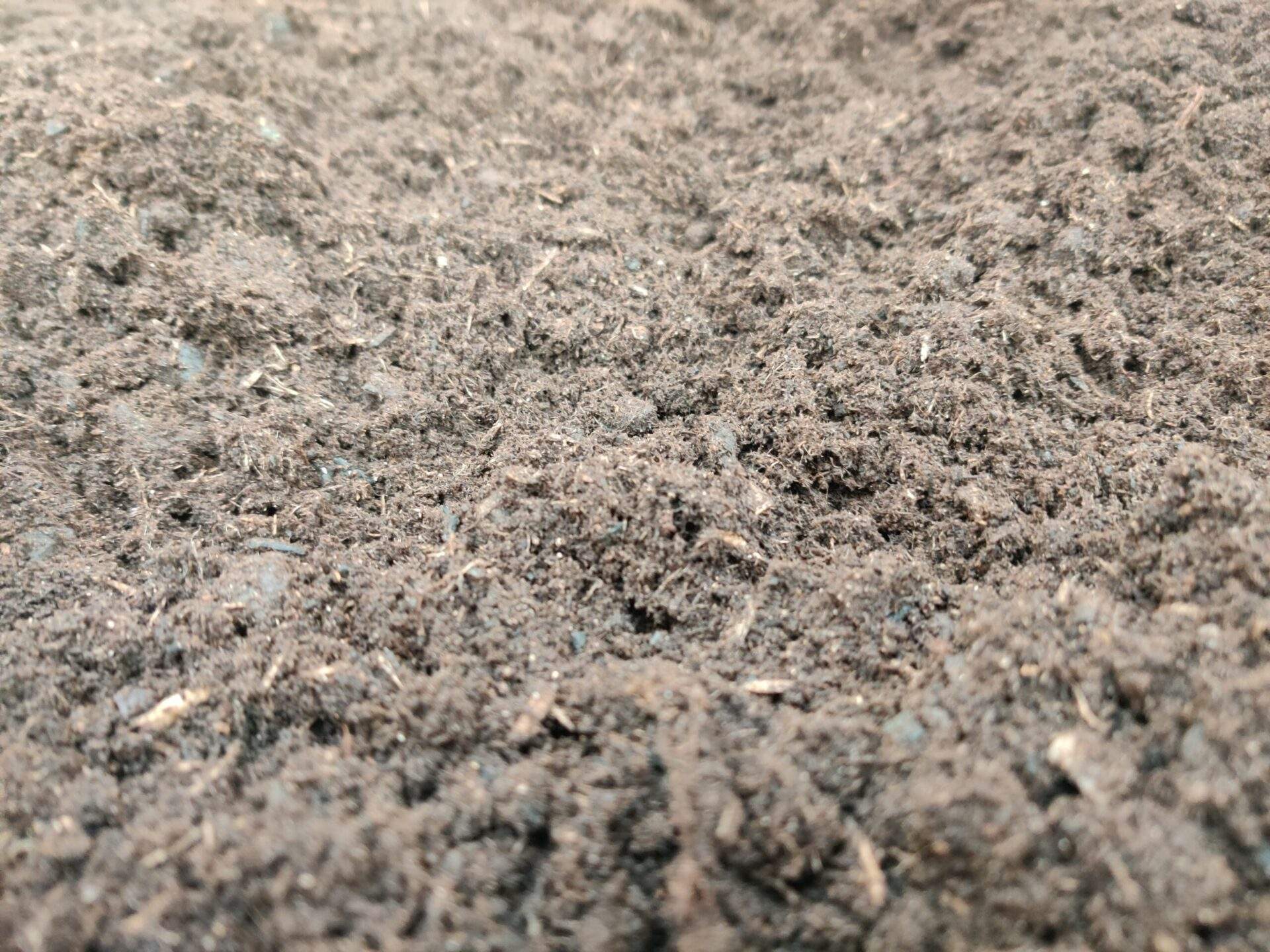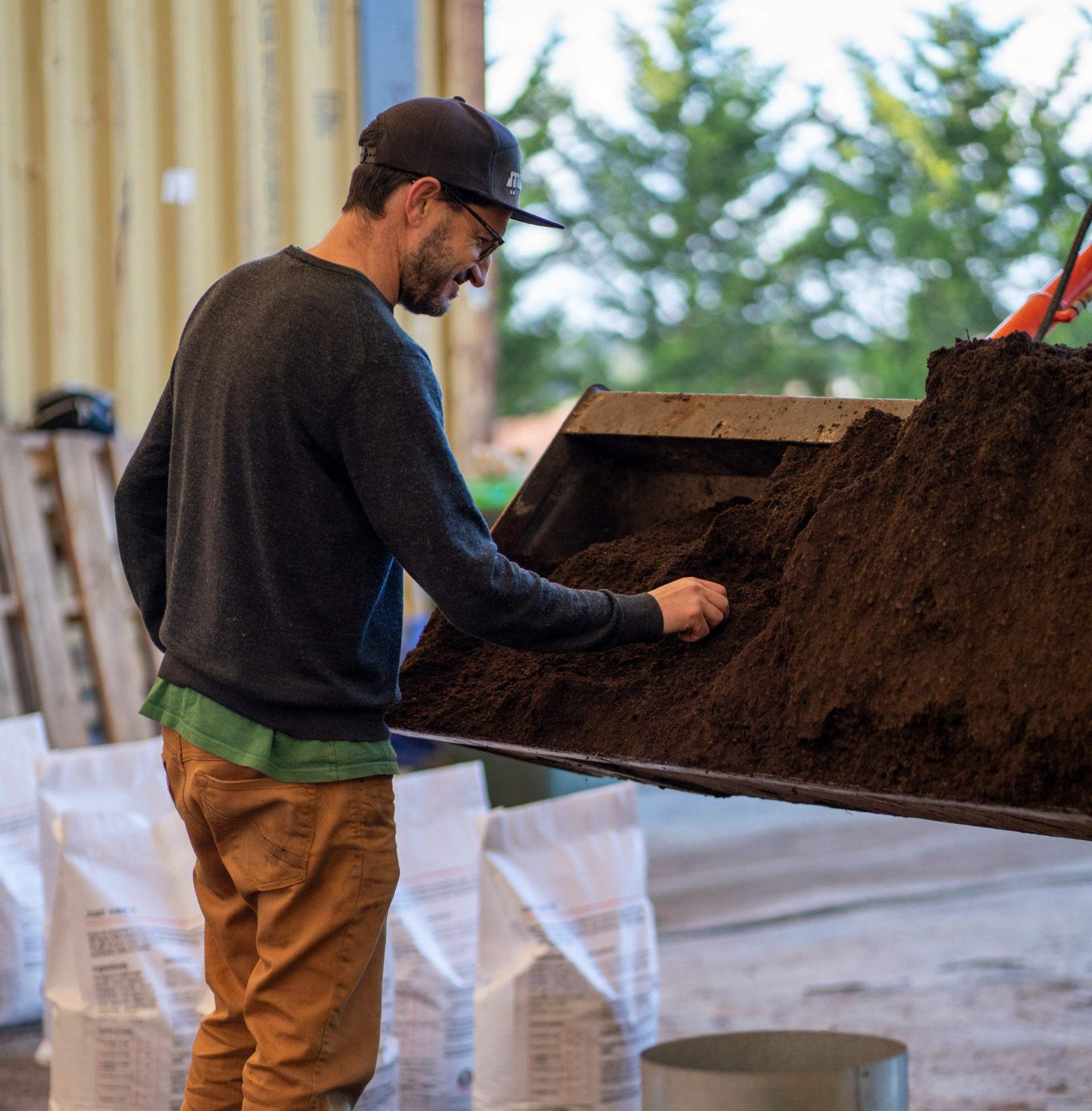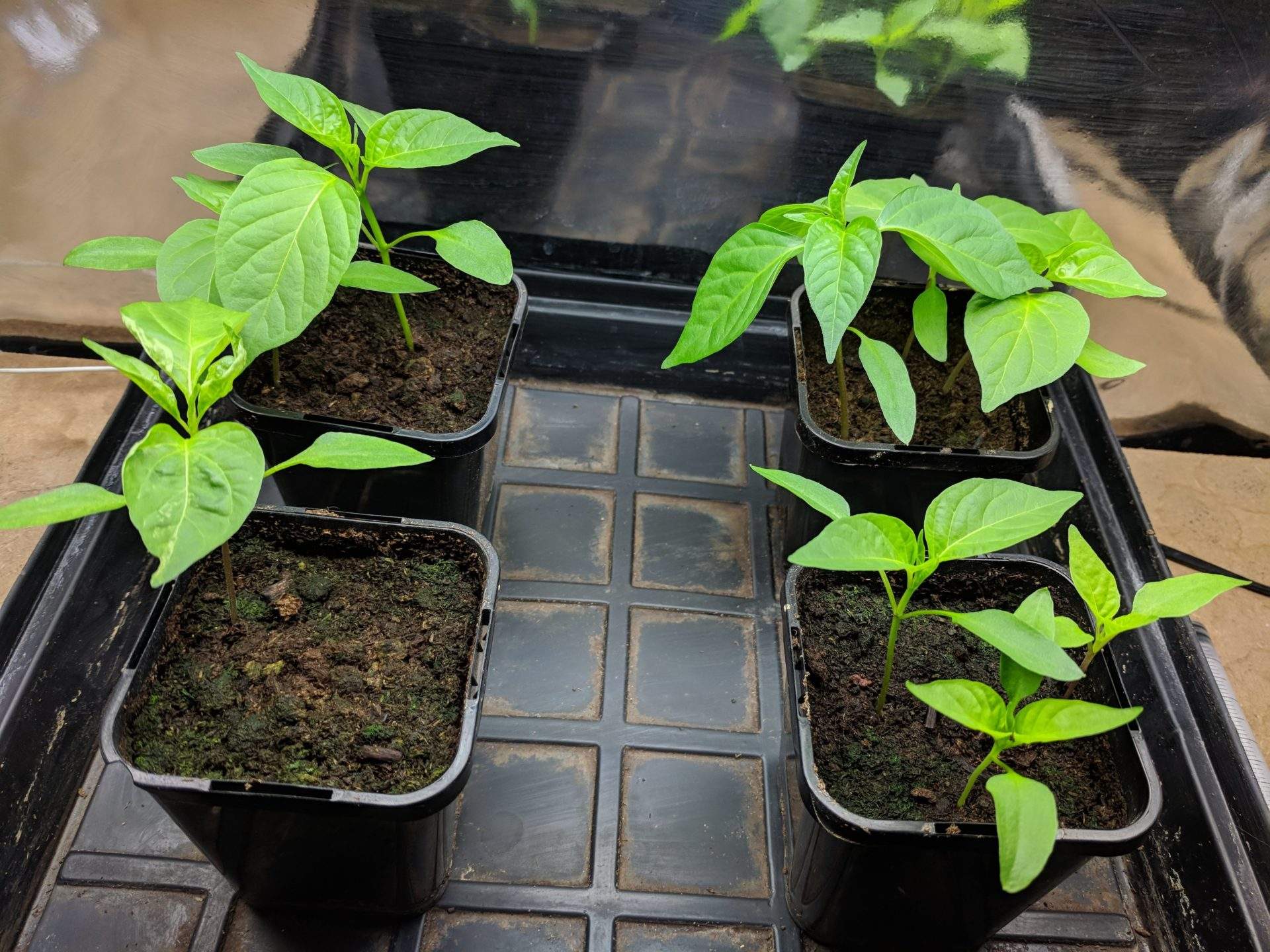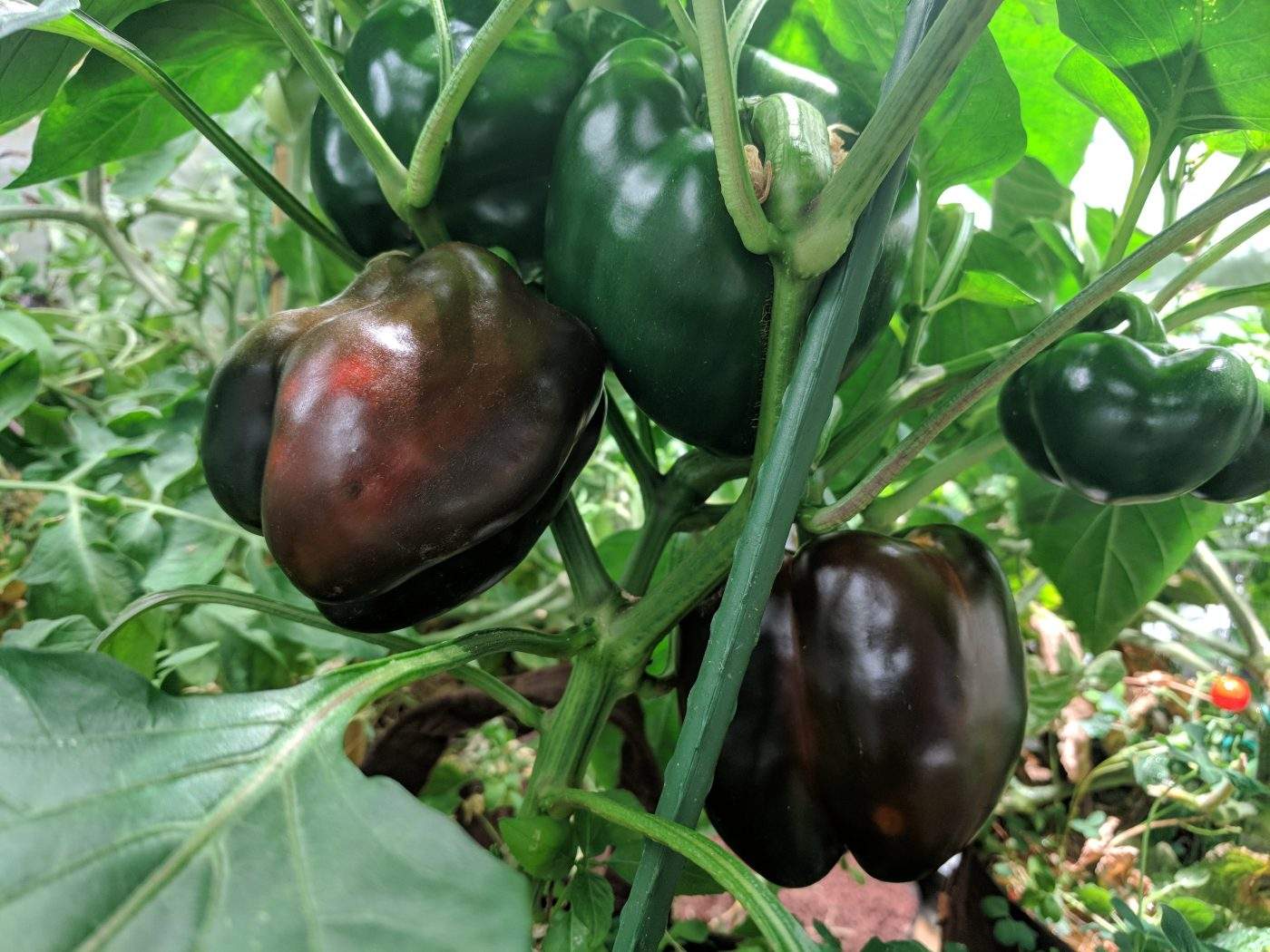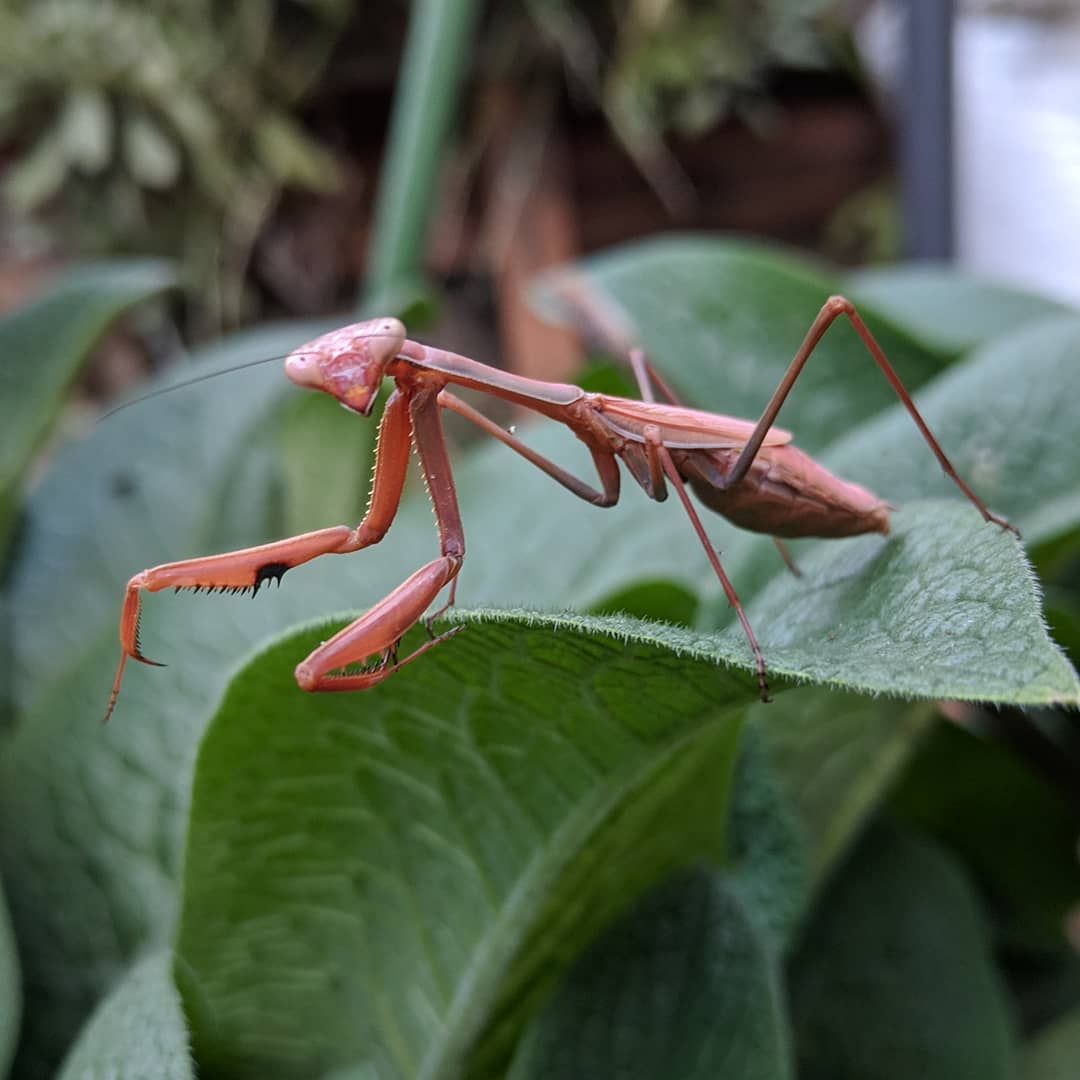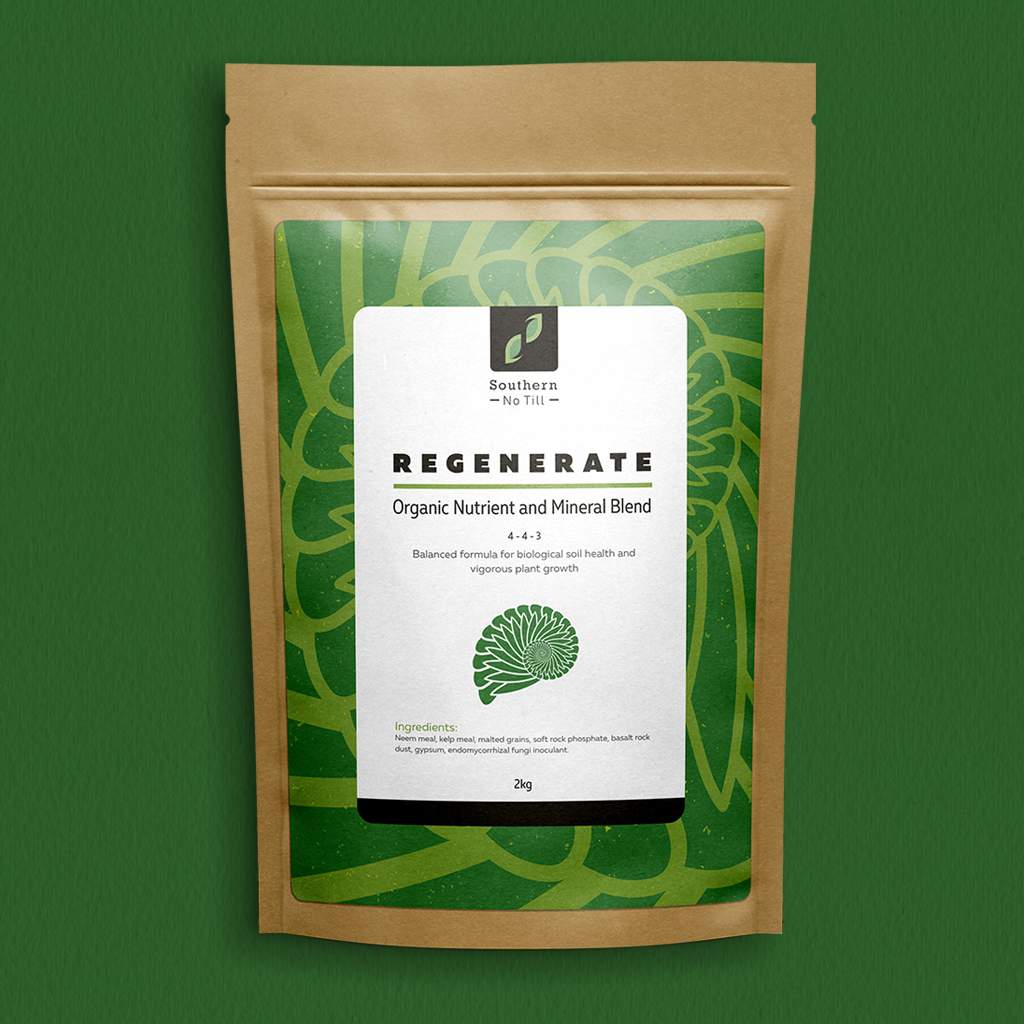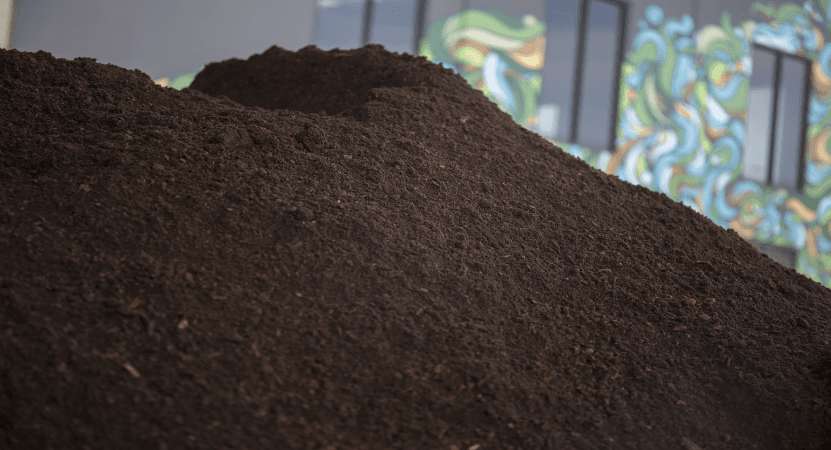Living Soil Formula Increases Organic Food Production In Home Gardens
It’s no secret, our gardens are an escape from the hustle and bustle of city life. We plant an array of heritage and common fruit and vegetable varieties with the hope of producing healthy, organic food that is full of flavour for our families. Unfortunately, despite our best efforts to grow our own food, the average yield from our vegetable gardens can often be disappointing (even with adequate water and fertilisers). In Melbourne, we not only contend with low sunshine hours but also poor-quality soils. Soils that contain poor physical qualities and chemical composition are the real cause of low-performing yields. It’s why we have developed the ultimate growing media at Easy As Organics – a potting mix that increases sustainable food production all year round.
Soil: The Foundations for Success
Melbourne soils (like many cities within Australia) are old and lack the appropriate nutrients and water retention qualities required to make a productive garden. Soil is so much more than dirt; it's formed by cycling geological and biological phenomena working together to produce the nutrient-filled basis of your garden. Just like the foundations of a house, it should be healthy and strong before you attempt to grow and cultivate your organic food.
Here at Easy As Organics, we understand that without high-quality soil it is simply impossible to produce high-quality yields from your garden.
Years of Research to Create a New Gold Standard
We've been working hard behind the scenes to fine tune the formulation of our flagship product, Easy As Organics Living Soil. It is a high-end certified organic soil media for potted and raised bed plants that we have been developing over the last 5 years.
We are proud to have completed years of research and development into creating the ultimate living soil media nutrient and physical profile. After extensive hard work in adjusting and balancing the physical and chemical properties of Living Organic Soil, we know that this product will take your home-grown organic food production to the next level. The new formulation is nutrient-rich and easy to work with, so it can be used in any kind of edible garden. These physical and chemical properties with the use of quality worm castings and compost has led to thriving biological properties and nutrient cyclcing potential for even the most demanding annual plant varieties.
Easy As Organics Living Soil is made of the highest quality organic materials, including composted plant matter, worm castings and peat moss. The new formulation includes the addition of Australian-made wood fibre, a new horticultural substrate, made in Victoria from soft wood chips. It is manufactured from thermo-mechanically defibred, sustainably sourced radiata pine wood chips from offcuts of the timber industry.
Living Soil is designed to provide your plants with everything they need for healthy growth without any of the chemicals or additives that are often found in synthetic potting media. The new formulation is scientifically designed for producing high-quality, high-yielding organic edible gardens, not just in Melbourne, but in all cities across Australia. We are confident that you will be amazed by the results.
The Right Formulation
As part of our Easy As Organics ethos, we only use the best quality organic ingredients, selected for their high nutritional value, carbon content, biostimulant properties and varying speeds of nutrient release.
In our new formulation of the Easy As Organics Living Soil, we have perfected the balance of fertility for nutrients and sufficiency whilst keeping heavy metals, sodium and chloride as low as possible. The minerals are expertly balanced, guided by analysis from EAL Laboratories and Logan Labs. This has been accurately achieved by testing and amending to the industry-standard nutrient target levels. The nutrient sufficiency, balance and targets have been met by drawing from a large dataset gathered over years by top-level organic crop and soil specialists.
In addition, we have improved the physical structure by replacing some of the scoria aeration material with new, locally made (right here in Melbourne), horticultural grade wood fibre substrate.
Living Soil is Key to Growing the Highest Quality, Nutrient-Dense And Vibrant Crops
The quality and nutrient density of a harvested crop from this soil must be experienced to be believed! Our trials have shown excellent results with our new formulation, particularly in relation to germination and early root development in seedlings. We have also reported significantly faster vegetative growth and fewer problems associated with overwatering. Even nutrient-hungry, fast-growing annual plants will absolutely thrive in this soil under the right conditions for multiple cycles in large containers. When moisture levels are dialled in using a moisture meter and automatic watering such as Blumat, even higher yields can be achieved.
The reason for the high yields, incredible nutrient density, and complexity of flavour and aroma is due to the science contained within this renewed and unique formulation.
Increased Air And Water Availability
The addition of the wood fibre creates higher air porosity than other leading soil media available in the market. The higher air porosity ultimately leads to greater capacity for the soil to hold oxygen. The increase in available oxygen in the root zone results in better efficiency of photosynthesis.
The fibrous growing media within Living Soil also has greater tolerance to both under and over-watering – and even performs well in less-than-ideal environments. The rewetting and water penetration properties are superb, providing better water distribution throughout the soil. Best of all, the soil does not become hydrophobic even after allowing the soil to remain dry for long periods of time (due to the addition of the soft wood chips).
Increased Microbial Activity
Furthermore, the new formulation also has increased aerobic microbial activity. These beneficial microbes can effectively break down the organic nutrients into more bio-available forms for the plant – the result is better nutrient availability and absorption by the plant.
The living soil encourages an ecosystem of beneficial microorganisms and predator insects. Over time you will see a diverse and rich ecosystem of insects underneath the mulch. These insects are part of the soil food web that helps to break down organic matter and releases nutrients in a plant's available form. Some insects will even produce compounds that destroy pests, boost natural plant immunity, and protect plants from disease!
In addition to the above, the bulk density of the soil media has been reduced by 25%, leading to lower freight costs, a lower transportation footprint, as well as easier and safer handling.
To learn more about the science behind some of our soil inputs, please visit our knowledge base.
Unlock The Potential
We are thrilled to launch the new formulation of Living Soil – our optimal soil media for potted and raised bed plants. Through our extensive and scientific assessment, we believe our unique soil blend will help you cultivate incredible organic food in your Melbourne garden. By encouraging impressive plant health, you can easily unlock the genetic potential of your favourite varieties for amazing plant phytochemical production. Get great yields, and produce exceptional harvests that a full of flavour and nutrients this season with our new Easy As Organics Living Soil.
Maximising potential in living soils
The following article is a guide to help growers achieve the highest quality harvests in living soils. I've compiled this method from many years of trial and error and generous sharing of knowledge with amazing and like minded organic gardeners. My company, Easy As Organics was built on the joy that I got from experiencing the richest flavours ever and growing the healthiest plants I'd ever seen. The guide obviously works for any quality living soil or similar tea that you make yourself. If you don't feel like making your own, you can purchase most of the organic products listed in the guide at my website, easyasorganics.com.au
Below are some basic tea and topdressing recipes for maximising genetic and yield potential in your living soil. These teas will improve microbial activity and nutrient cycling, pest resistance and terpene/flavonoid production while reducing maturation time.
Neem Kelp Tea. For botanical nutrition and IPM.
- 1/2 cup neem meal
- 1/4 cup kelp meal per 19L water.
- Brew for 18 to 24 hours by stirring occasionally. Water your soil with this solution.
Malted Barley Powder topdress and tea
Top dress 1/4 cup freshly ground malted barley per 50L of soil or about 1 cup per m2. Alternatively, add about 56 grams of ground, freshly sprouted seeds to 19L of water and add the following:
- 2.5 ml/L Fulvic Acid
- Freshly blended aloe fillet or 1 tsp of Southern No Till Aloe Powder to 19L water
Coconut Water enzyme tea
- 1.25 cups organic coconut water per 19L water.
- 1 tsp Southern No Till Aloe Powder or a freshly blended aloe fillet
Integrated Pest Management (IPM)
Weekly Foliar Spray:
- 1/2 tsp Aloe Powder or a cup of aloe fillets blended in 4L of water. Ensure you dissolve the aloe powder in solution before adding emulsified oils. For triggering systemic acquired resistance: SAR. A natural plant immune response.
- 1 - 3 ml/L of cold pressed neem oil, emulsified in shot glass with a few drops of Doctor Bronners Liquid Soap (baby soap, unscented) or a tsp of liquid potassium silicate.
- Alternatively, emulsify a couple drops of organic rosemary, lavender and/or peppermint oil (.5 ml/L total essential oils) with a few drops of Dr. Bronners' liquid soap and mix into water with the pre-blended Aloe Powder or fresh aloe.
- Stir solution vigorously in the 4L tepid water and apply with a quality v-pattern pump sprayer to top and bottom of leaves at sun down or when lights turn off. Repeat this once per week for about 5 to 6 weeks total.
- For excellent long term pest resistance, introduce predatory insects once the foliar program is complete. Predatory mites and other beneficial predatory insects will feed on any pest eggs or adults that may have been left behind after your foliar sprays. With proper care they can also become part of the soil food web ecology and help keep your plants safe from pest attack for more than a single growing cycle. See bugsforbugs.com.au for more info.
The above schedule is a guide only. Botanical inputs such as neem meal and kelp meal can be swapped with or mixed with other inputs to make your own nutrient and phytochemical rich teas. However, this simple, sustainable and economical cultivation schedule has proven to work very well for me and many others so it's a great foundation to start with. After a few weeks you should notice unparalleled peak plant health displayed by incredible leaf turgor, vigour, intoxicating aromas and dark green, shiny leaves, virtually resistant to pests and disease. Please keep in mind that this schedule should not begin until the seedling or cutting has established itself in the container or raised bed and is developing at a healthy rate. Only then, begin "Week 1". In between teas water lightly as needed to make sure soil stays evenly moist but not so wet that water runs out the bottom of the container. Water as little or as much as required to maintain the perfect soil moisture. This will vary depending on plant life stage, pot size, temperature, humidity and other factors.
A performing soil must contain a balance of air and water for roots and soil microbes to access oxygen and expel CO2. When the moisture content of your soil is dialled in, you will notice amazing plant health and general vigour. If the soil is watered too much, the soil porosity will be completely taken up by water, not allowing for any air to enter the rootzone which will not only slow plant growth to a halt but also set the stage for pests and other unfavourable soil conditions. Only supply enough water to keep soil just moist. Once watering is mastered, the rest is a breeze.
When preparing soil for growing, plan for the length of time that your plant will be in the container, as well as the general size and vigour of your chosen cultivar. We’ve found that a fast growing annual grown indoors for a 4 week vegetative period and an 8 week flowering period will have all it’s nutrient requirements met from a 50L pot of Easy As Organics Living Soil with just water. Use this as a basic guide to figure out how much soil you will need for each plant in your garden. For example, a large, vigorous cultivar that you plan to grow outdoors in a container for an entire hot summer season from November to May, the total number of weeks the plant will be growing in that container will be roughly 25, give or take. This is double the amount of time as the above example of an indoor plant life cycle so not only will we want to double the soil volume but also consider the harsh outdoor Australian summer climate and increase soil volume by 2.5 to 3 times the indoor garden. In this outdoor garden you would need about 150L for uninhibited plant growth for a luxury plant buffet of nutrients and water.
Now that you’ve figured out what size container to grow in, water thoroughly until all soil is evenly hydrated and equalised throughout soil, but not so much that you see runoff. You should be able to squeeze the soil in your hand and only a drop should barely come out. If you know the particular plant variety is an extra hungry and vigorous cultivar, a handful of Regenerate blend scratched into the top layer of soil and covered with a thin layer of worm castings will add to the nutrient bank and further boost beneficial microbes for your plant’s future growth cycle. The microbes in the worm castings will start mineralising organic nutrients from the Regenerate blend while also immediately supplying plant available nutrients. Apply MycoBiome mycorrhizal fungi powder directly to the roots of your transplant, clone or seed and place into the soil, covering roots with more soil. The MycoBiome powder will inoculate your soil with an incredibly important part of the soil food web, mycorrhizal fungus. Mycorrhizal fungi extracts nutrients and water contained in your soil's cation exchange sites and wraps itself around soil particles, holding them together, improving soil structure. The plant can then take up more nutrients at an efficient rate by forming an association with the fungus at its roots, in exchange for sugars infused with carbon. This will greatly increase the nutrient cycling ability of the soil ecology and the plant’s ability to take up nutrients as well as protecting itself from pest and disease attack.
Watering technique is key to success in living soils. When you first plant into properly prepared, hydrated living soil, you may find you don't need to water again for some time as the seedling establishes itself. This is the most common time for growers to over water. Avoid the temptation and wait until your seedling begins to take off! After using these methods for 1 to 2 growing cycles you will notice a visible level of microbial life underneath the mulch layer and no pest pressure. This diverse microbiome will increase in beneficial predatory mites and other insects, fungi, predatory nematodes and much more, as they all help the plant grow to its ultimate potential. Plant health should remain constant and unnecessary stress factors should be avoided such as transplanting or changing light spectrum. Input requirements will be reduced to a simple fortnightly botanical tea or amendment topdressing to deter pests, maximise terpenoid expression and keep your soil nutrient bank (total cation exchange capacity) full for a constant luxury plant buffet. Using these methods and the above amending and tea schedule, the greatest quality harvests can be achieved.
Written by Matt Barnes, Easy As Organics.
Potting Mix Trials Update
- Easy As Organics Water Only Soil vs Commercially Available Certified Organic Potting Mix
Plants grown in biologically active soils exude compounds from their roots via photosynthesis to attract microbes into the rhizosphere in exchange for the nutrients it needs. The more diverse a soil microbiome, the more effective this natural process is. This is very different to a conventional approach where the grower will be the one responsible for providing nutrients in ionic form to the plant directly via a liquid solution. I hope that this trial will demonstrate clearly the true nature of living soils in action when compared with a regular organic potting mix that can be found in any local nursery or department store.
The hypothesis:
Plants grown in Easy As Organics Water Only Soil will out-perform a commercially available certified organic, certified to meet Australian standards for compost (AS4454) potting mix. The performance will be noticeable in the later stages of vegetative growth towards flowering and especially in yield and quality.
The label on the commercially available potting soil product claims to be a rich organic potting mix with enough nutrients for 3 months of healthy plant growth.
The methodology consists of 4 plants, each growing in a 45L container inside a 1.2 x 1.2m growing tent. An extraction fan was installed to pull fresh air via a centrally located vent at the bottom. A single 315w ceramic metal halide lamp mounted in a reflector at the top of the tent with a light cycle of 15 hours on and 9 hours off will provide wide spectrum lighting.
Plant variety is Purple Ghost Chilli from a renowned chilli breeder. Seeds were propagated in a seed raising mix containing 80% peat, 10% aeration, 10% worm castings and amended with lime and kelp meal. 4 seedlings with the most similar characteristics were planted in each 45L container. The 2 growing on the left is growing in Water Only Soil and 2 on the right is Certified Organic Potting Mix (un-named)
An automatic, gravity fed Blumat system was installed. Rather than introducing a variable by hand watering, plants are only taking what they needed based on soil requirements.
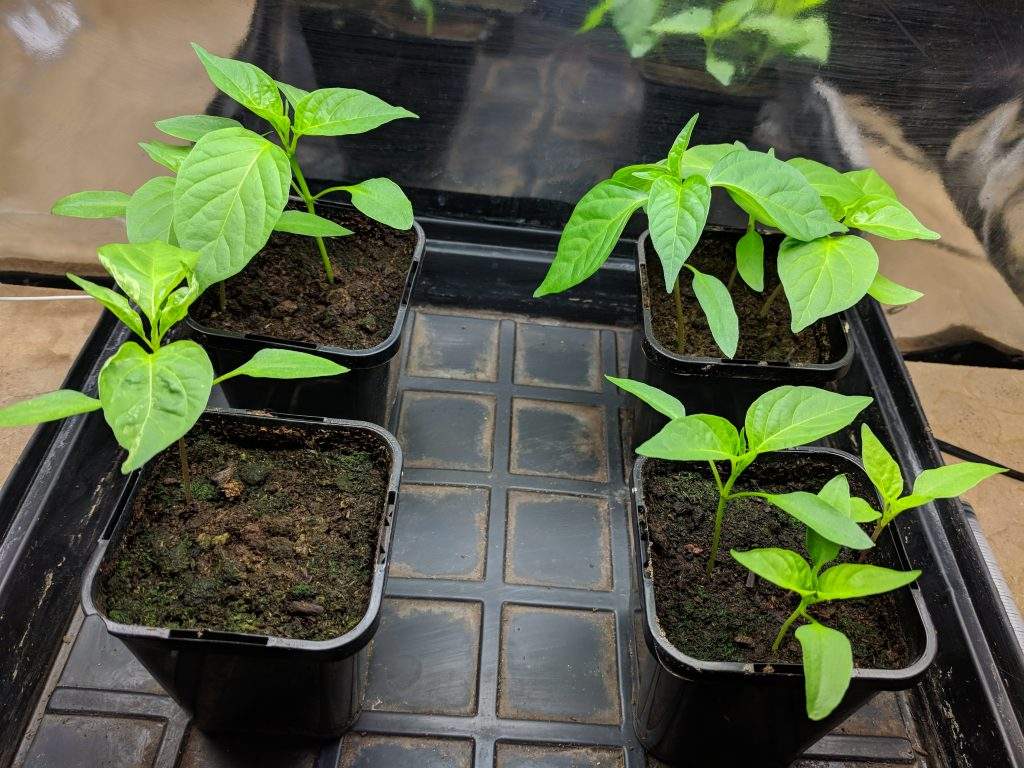
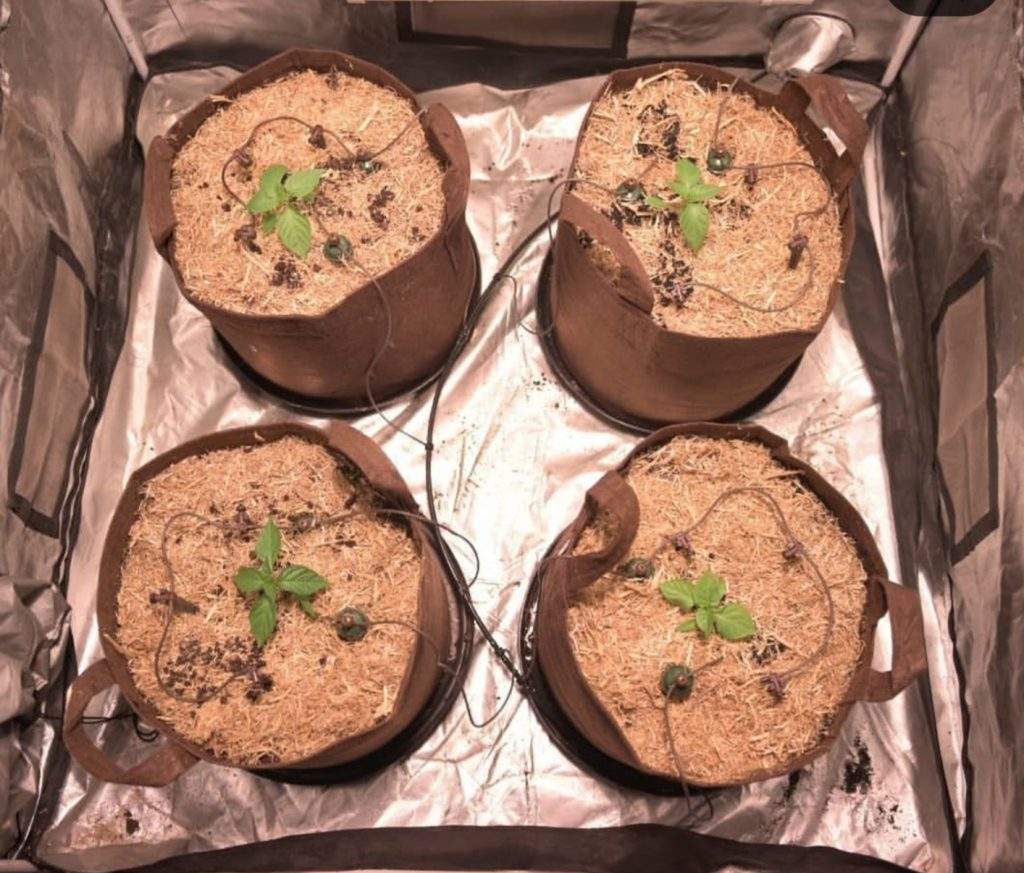


It should be noted that temperatures have been very cold and are contributing to the slower rate of growth. I placed a gentle greenhouse bar heater to take the chill off.
Living soil on the left is clearly ahead. I was not expecting this dramatic of a result so soon in the trial. Both potting soils and leaf tissue samples will be sent to a lab for analysis at the end so we can have more data to help make sense of the results. Hopefully the experiment can help those looking for higher performing soils containing better ingredients but are perhaps hesitant to spend extra money. Stay tuned for updates and a time lapse video at the end of the trial!
Living organic soil vs standard organic potting mix
Grow trial
For this trial I have 3x 45L fabric pots with our Water Only Soil and a single 45L fabric pot with the most expensive organic potting soil available from Bunnings.
Organic purple ghost chillies have been propagated from seed and I'll pick 4 of the most similar look seedlings for the trial. The seeds were coated in a mycorrhizal inoculant and will get a second dusting of mycorrhizae when transplanted into their containers.
Blumats will be taking care of watering automatically so all pots will get a steady supply of water based on its individual needs.
No Till Gardening and Mineral Balancing in Containers
Growing in living organic soil has endless benefits when compared with more conventional methods that require careful and measured applications of synthetic chemical fertilisers in inert growing substrates. Some of these benefits include unparalleled complexity of flavour and aroma, nutrient density and overall superior crop quality, cost savings and environmental sustainability by reusing soil over multiple growing cycles with no-till cultivation principals. A high quality, well constructed living potting soil will have a high CEC (cation exchange capacity, the measure of its ability to hold minerals, nutrients) and water holding abilities which not only reduces the need for fertiliser inputs but also presents a potential solution to harmful nitrate runoff into the environment and wastage of precious water resources. I’m going to address CEC and how it relates to no till gardening for the purpose of this article.
Cation exchange capacity and base saturation
Firman Bear and William Albrecht began researching the cation saturation ratio system in the 1940s and 50s. They discovered that most fertile soils contained nutrients in similar ratios. These highly productive soils had similar physical and chemical properties with thriving microbial populations.
Let’s look at CEC and base saturation and why they are so important to consider in your living organic soils.
Cation exchange capacity is a measurement of how many mineral cations the soil can hold on to. Cations are positively charged nutrient ions consisting of calcium, magnesium, potassium, sodium and trace elements. The higher the soil CEC, the more negative exchange sites are available to hold onto minerals. The aim when building a quality living organic potting soil from a mineral balancing perspective is to fill the soil exchange sites with a ratio of about 70% calcium, 10% magnesium, 4% potassium and 1.5% sodium… leaving the rest for trace elements and exchangeable hydrogen. The higher the CEC, the more forgiving the ratios are and the longer your plants will be able to take up nutrients without having to replace them via topdressing.
When CEC is filled close to the ideal ratios, the soil will have a mineral composition that encourages optimal physical properties to provide an ideal habitat for beneficial soil microbes. This enhances plant microbial interactions which allows efficient nutrient uptake by plants through root and microbial exudates. Both the plant roots and microorganisms can exude hydrogen ions and exchange them for calcium or other cations efficiently. This exchange is what keeps soil pH optimum, at around 6.4. A well constructed living organic potting soil takes all of this into account for maximum crop performance and dense mineral content. The end results are crops that contain superior flavour and aroma from huge secondary metabolite production and nutrition from yields limited only by plant variety and general cultivation practices such as watering technique and environmental conditions.
Our Water Only Soil has a CEC of 33 and a water holding capacity of 64%. The high CEC and high water holding capacity is what enables the soil food web to efficiently exchange nutrients with plants as needed.
No till cultivation to create soil health for the long haul
Many annual crops have high nutrient demands and will extract nutrients, minerals and organic matter from soil over time. Organic matter must be returned to the soil after harvest for the next crop. This can be achieved by keeping a constant mulch layer and sprinkling light amounts of a balanced amendment blend in between crop cycles.
When topdressing, work amendments into the upper inch of your soil and add a layer of the highest quality worm castingsyou can get a hold of. Always mulch with straw to encourage even moisture content. Mulch will also supply constant organic matter. A constant supply of organic matter helps carbon cycling in the soil through increased microbial activity that breaks down minerals into plant available form. The continual addition of mulch will create humus through microbial decomposition. Humus increases the CEC of your soil which improves the capacity to provide for crop requirements as needed. Frequency of application will depend on soil volume and plant age. The smaller the container, the more frequent mineral and humus applications may need to be applied.
No till cultivation is not recommended in container sizes under 50L as the soil food web will not have the space to function effectively. Raised beds with ample soil volume and a constant layer of organic mulch would be enough to stimulate microbial activity. This will ensure constant nutrient cycling for efficient crop production. Small applications of our Regenerate blend in between crop cycles will keep cation and other nutrients at optimum levels. Cover crops are an economic and effective source of organic matter. Planting cover crops in your soil will encourage biological diversity, soil structure, nitrogen fixation and carbon cycling and is a free source of mulch. No till gardening is a highly effective method of maintaining and increasing soil fertility for many years.
Regenerate is a balanced blend of organic amendment meals and mineral rock dusts with a mycorrhizal inoculant. This blend contains gypsum, neem and kelp meals, soft rock phosphate, basalt rock dust, malted barley and mycorrhizae. Its most effective when topped with a layer of worm castings to quickly make the nutrition plant available. Your living organic soil should increase in fertility over time, reducing water and input requirements.
Consider the balance of cations as well as your soil CEC. Applying too many fertiliser inputs can alter this balance and do more harm than good. If managed well, your soil can provide harvests for a lifetime.
Worm castings, soil gold
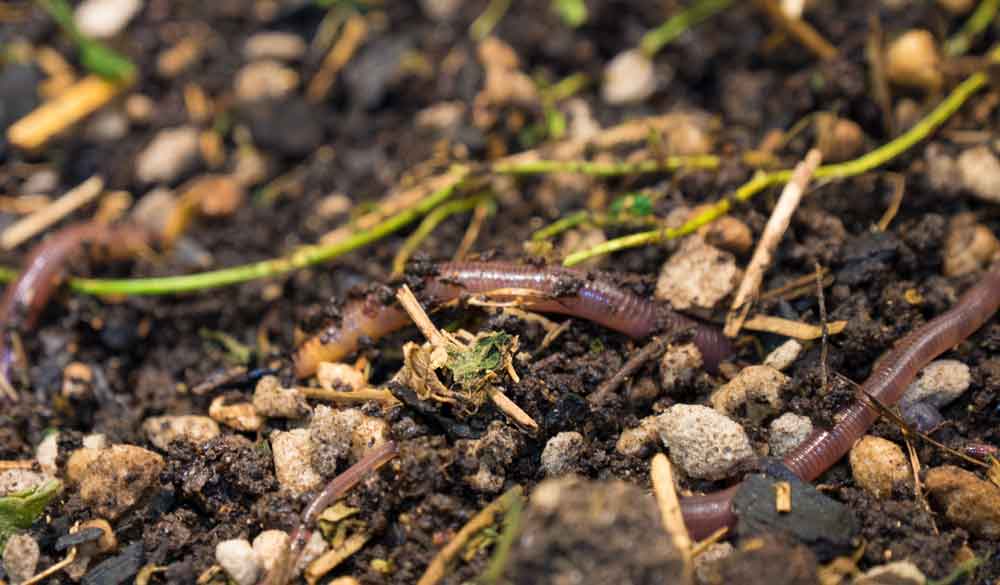
Vermicompost is the key to successful organic crop production
Earth worms have been studied by philosophers, pharaohs and scientists for thousands of years. Cleopatra VII, the last Egyptian Pharaoh sentenced to death anyone attempting to smuggle worms out of Egypt. Aristotle called worms "intestines of the earth". The productive role of earth worms in the cultivation of crops have only been properly researched in recent decades. Vermicomposting helps solve waste problems by digesting raw organic food scraps, manures and other organic materials through biological decomposition and excreting a perfect fertiliser called worm castings or vermicast. It is a fertiliser rich in NPK, micronutrients, plant growth regulators and an incredible diversity of highly beneficial soil microbes. Effectively, compost worms transforms organic waste into soil gold.
Worm castings are the richest source of humus
Vermicompost contain a high level of humus, rich in humic acid. This improves air porosity and water holding capacity which dramatically increases health and vigour of young seedlings and mature plants. Humic acid contained in worm castings have many cation exchange sites that hold plant available nutrients such as calcium, iron, potassium, phosphorus, magnesium and sulfur. It holds onto these plant available nutrients in solution and releases them to plants when they need them. The humic acid in worm castings dissolves organic minerals, stimulates root growth and reduces plant stress while enhancing nutrient uptake.
The high humus content in worm castings provides disease and pathogen prevention from unwanted organisms such as root rot. Worm castings contain beneficial microorganisms and are many times higher than populations found in most soils and thermophilic composts. Earthworms stimulate these soil microbes such as nitrogen fixing and phosphate solubilising bacteria as well as actinomycetes and mycorrhizal fungi. Worm castings are the most important input in your soil due to the high content of humus and slow release, plant available nutrients.
Natural plant growth promoting hormones
Worm castings promote incredible growth and plant health beyond what simple nutrient uptake could ever achieve. This comes from the many forms of natural growth hormones contained in the vermicast. Studies have shown worm castings to contain cytokinins, auxins and flowering hormones, gibberellins. Plants grown in soil that contains worm castings show faster flower development than without worm castings.
Pest and disease prevention
Vermicompost has the ability to ward off and prevent pest attacks from hard bodied insects such as spider mites and aphids. This is due to the chitinase enzyme produced by the worms which destroys the insect bodies made of chitin. The addition of chitin inputs in your soil like malted barley or crustacean shells will further stimulate chitinase enzyme-producing microbes. The diverse polulations of microbes have the ability to out-compete pathogenic organisms, drastically reducing fungal disease and root knot nematodes.
Vermicompost in your soil mixes
Studies show undoubted benefits from the addition of worm castings to your potting mixes and garden beds. Vermicompost can be used by topdressing soil and watered in or blending into a potting mix at 20% of total volume for maxium benefit. Worm castings are the key to successful organic crops and eliminates the need for harmful chemical fertilisers.
Organic Pest Management Tips
Organic cultivation requires natural methods of dealing with pests. Organic pest management methods should take into account the preservation of soil microbiome and biodiversity in general regardless of the pest you may be dealing with. For my first tip, I'm going to lump 3 common but nasty leaf sucking pests into one management process. Thrips, spider mites and aphids. First of all, ensure all environmental practices such as watering and temperature are optimal for soil health and plant growth. Unhealthy plants send signals to pests to be eaten. Once you have determined your pest is one of the ones mentioned above, make a foliar spray consisting of an all natural neem oil product at the rate of 2-3ml/L and spray all leaf surfaces top and bottom at sundown every 3 days for at least 4 applications to break the breeding cycle. Then, order some cucumeris predatory mites from Bugs for Bugs at www.goodbugs.org.au and stop foliar spraying. These highly effective, all round predator mites will feed on the larval stages of thrips and mites. Additionally you can introduce californicus predatory mites if spider mites are a more severe problem, however after 4 foliar applications of neem oil there should only be a small pest population left. In a living organic, probiotic garden, introducing beneficial predatory insects is an excellent way to not only control pests but to increase the biodiversity of your garden which is what we should strive for with organic cultivation practices.
New Products: For re-amending no till gardens and recycling old soil.
No till, organic gardening is our passion and we are really excited to launch Southern No Till, a brand that is fully dedicated to all natural cultivation styles. Our product range will include organic, minimally processed raw soil amendments, high quality compost and worm castings and many more living organic soil building inputs.
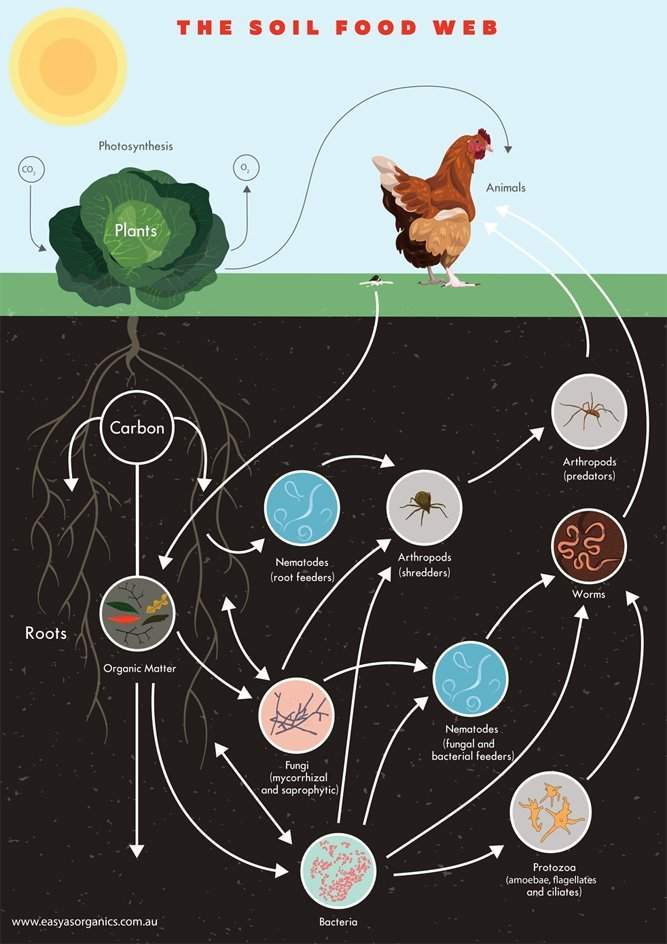 Southern No Till’s focus is on the soil food web: the complex microbial community responsible for effective nutrient cycling and ultimate plant health in optimal soil. All of our organic gardening inputs are carefully considered for soil microbiome health and are mostly plant and rock mineral derived. We’ve chosen plant and mineral sources that bring maximum benefits to the table per square centimetre, hence why we’ve introduced the following 3, highly effect organic and no till gardening products for availability in our store.
Southern No Till’s focus is on the soil food web: the complex microbial community responsible for effective nutrient cycling and ultimate plant health in optimal soil. All of our organic gardening inputs are carefully considered for soil microbiome health and are mostly plant and rock mineral derived. We’ve chosen plant and mineral sources that bring maximum benefits to the table per square centimetre, hence why we’ve introduced the following 3, highly effect organic and no till gardening products for availability in our store.
Neem Meal and Kelp Meal provide a huge array of plant and microbe-promoting benefits beyond the NPK profile. Neem meal is an amazing botanical source of nutrients with a balanced macro and micro nutrient profile. Neem meal is created after the oil is pressed from the seed and is a true sustainable source of green manure. It contains pest-resisting limonoids which act as an anti-feedent and also disrupts breeding and laying of pest eggs. Our kelp meal is minimally processed. This preserves the many secondary metabolites present in kelp that stimulate plant health and growth. These beneficial secondary metabolites are destroyed during the processing of concentrated kelp extracts. Powerful growth promoting hormones naturally contained in kelp include cytokinins, gibberellins, auxins, indoles and many others. This whole kelp meal will provide a balanced spectrum of minerals and micro-nutrients. Kelp contains over 60 trace elements.
Recharge Nutrient and Mineral Blend is a great way to topdress, build new soil or recycle old soil from a single blend of carefully selected ingredients. It is a plant-based amendment and rock dust mineral blend which is perfect for re-amending soil beds and containers in between growing cycles, especially for people who don’t have the resources to get their soil tested as it contains a wide array of slow and quick release nutrients and minerals in organic form for microbial stimulation and long term soil fertility throughout the growing cycle. We’ve also added an Australian made mycorrhizal inoculant. I’ll save the massive benefits of adding mycorrhizal inoculants to containers and raised beds in living soils for another blog article!
Recharge contains:
Neem Meal: pest resistance, macro nutrients. Certified Organic
Kelp Meal: Growth hormones and micronutrients. Certified Organic
Malted Barley: Enzymes for faster microbial action
Paramagnetic Basalt Rock Dust: Raises soil fertility and provides slow release trace elements
Gypsum: Certified Organic. Provides sulfur and calcium and does not affect pH. If building your own soil, add appropriate amount of calcium carbonate if correcting acidic soil from the addition of sphagnum peat moss. We left out lime so your soil pH will not shift over time and become more alkaline.
Soft Rock Phosphate: Naturally sourced, un-processed rock phosphate high in trace elements, calcium and phosphorus as well as silica - a cell strengthening element.
Mycorrhizae: Contains 4 species of endomycorrhizal fungal spores. Made in Australia
Hemp Health and Innovation Expo Melbourne 2018
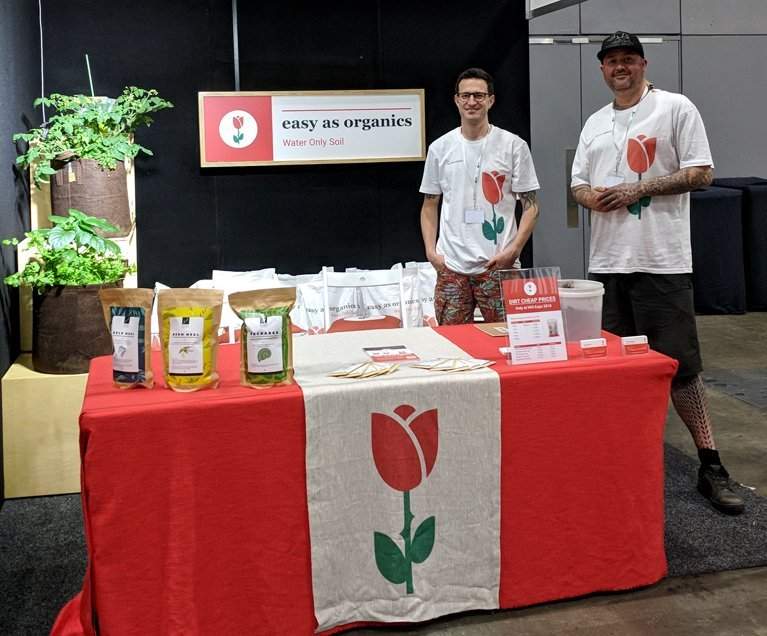
The Hemp Health and Innovation Expo has become a major showcase for up and coming entrepreneurs and established companies alike. It presents incredible opportunities for the general public to discover first hand the massive potential benefits of hemp and medicinal cannabis directly from experts in the industry. Exhibitors at the Melbourne Hemp Health and Innovation Expo showcased a wide range of businesses offering innovative hemp food and beverages, medicinal information and products, building materials and of course, cultivation equipment and materials.
We were very impressed by the public’s growing knowledge of organic growing methods using living soils in containers. People were very receptive to organic cultivation methods as an environmentally sustainable and healthy alternative to using synthetic bottled nutrients in a sterile growing medium. Some of our HHI Expo customers have already given us great feedback about how well their Easy As Organics Water Only Soil is performing. Two customers have even setup controls to compare the difference between conventional growing and our water only living organic soil and are thrilled with the results so far.
The HHI Expo is an excellent forum for networking and public awareness for both the general public as well as businesses. We look forward to seeing you at the next show in Sydney 2019.
Easy As Organics Soil Blend - What's it made from?

Easy As Organics Soil Blend - What's it made from?
In our soil blends, humus is the most important factor as it contains all biology required for a fertile and highly productive soil blend. These microorganisms produce humic substances, stimulating root and shoot growth and increasing the breakdown of NPK and trace minerals. They create soil structure and protect your plants from disease-causing organisms. Quality humus is essential as it contains all life, carbon and humic acids to build ultimate soil structure for water holding capacity and nutrient availability. Bacteria make the glues that create aggregates which fungal hyphae then hold together. This creates larger particles and opens pathways for plenty of oxygen and water to enter the soil. Bacteria and fungi create slimes, acids and enzymes which break down raw, organic nutrients and exchange these ions for plant root exudates. The microbial activity then attracts larger microbes that prey on bacteria, fungi and organic matter, further cycling plant available nutrients and creating pathways for water and oxygen. This natural process builds a fertile soil, an aerobic environment which is essential to fostering a productive soil food web. This food web includes all the beneficial, disease-supressing microbes that will ultimately work for you and your plants. Living compost increases water holding capacity and eliminates the need for chemical fertiliser input. It chelates minerals through a natural abundance of humic and fulvic substances. Compost contains positive and negatively charged ions that attract and hold on to nutrients and minerals, eliminating any leeching that would occur in soil devoid of humus. After a few weeks of growth in our soil blends, you will notice worms crawling around underneath the mulch. Their cocoons which are in the castings will hatch and produce worms that are hugely beneficial to the nutrient cycling process.
Our soil is produced on site at Circular Food, Australia's largest urban worm farm. These castings are used in our blend and are added directly from the worm beds with no transportation. We use high quality aged compost and Big Bio Worm Castings to ensure the widest spectrum of humic substances, nutrients, enzymes and microbes are present in abundance. This is the driving force of Easy As Organics Soil Blends and is what makes multiple bountiful harvests possible in single fabric containers as small as 50L!
Neem Meal and Kelp Meal provide a huge array of plant and microbe-promoting benefits beyond the NPK profile. Neem seed meal is an amazing botanical source of nutrients with balanced macro and micro nutrient profile. Neem seed meal is created after the oil is pressed from the seed and is a true sustainable source of green manure. It contains pest-resisting limonoids which act as an anti-feedant and also disrupts breeding and laying of pest eggs. Acadian kelp meal is minimally processed. This preserves the many secondary metabolites present in kelp that are hugely beneficial to plant health and growth. These beneficial secondary metabolites are destroyed during the processing of concentrated kelp extracts. Kelp contains cytokinins, gibberellins, auxins, indoles and other natural growth promoting hormones which all act as powerful growth promoters. This whole kelp meal will provide the full balanced spectrum of minerals and micro-nutrients. Kelp contains over 60 trace elements.
Biochar is blended into the soil and has been pre-charged with nutrients and microbes. We source our biochar from Charman who produces the highest quality char that we could find in Australia. It's made from walnut shells and has a massive surface area. It holds carbon in soils for an extremely long period of time, increasing long term soil fertility, stimulating microbial activity. This helps immensely in long term no-till container gardening due to char's ability to hold on to water and nutrients like a sponge and provides a perfect home for the plethora of life present in the soil.
Malted barley has been added for it's chitin which is broken down by bacteria to create the enzyme chitinase. This enzyme degrades pest eggs and prevents gnat and other larvae from maturing. It helps nutrient cycling at the initial stage of composting a new soil mix due to the large amounts of enzymes released into the soil.
The mineral mix that is added includes basalt rock dust of the highest paramagnetic reading of any quarry in Australia. It reads at about 1600 to 2000 cgs. Calcium bentonite from Western Australia is added to increase CEC and calcium availability while gypsum and Gippsland Coral Lime (oyster shell flour) is added to this mineral blend and mixed into our soil at luxury levels. Crushed rock dust provides mineral food for soil life and stimulates their activity.
Canadian sphagnum peat moss and an aeration amendment of scoria is used as a base for this soil blend. Canadian sphagnum peat moss has been chosen instead of coco coir due to its superior cation exchange capacity 100 - 200 compared with coco's 40 - 60. There are many naturally occurring microorganisms and elements in peat moss including sulphur which helps terpene expression significantly. It has an incredible water holding capacity.
After all of the above components are thoroughly mixed, inoculated with task-specific bacteria and mycorrhizal strains, then hydrated and left to sit in cubic metre piles to allow a microbial nutrient cycling process to take place and create a perfect soil blend. After a few weeks, the soil is bagged down and sold. You can expect amazing performance, stunning plant health and vigorous growth in Easy As Organics Living Organic Water Only Soil.

